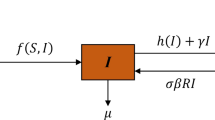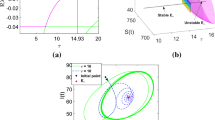Abstract
In this paper, we propose a mathematical model with a saturated treatment rate in the presence of information. We consider that the information about the disease affects the transmission rate of infection and hence the transmission rate is corrected. We also assume that people are losing their immunity against disease and the model is of SIRS type. We analyse the stability of the model system and our analysis shows that the model possesses the existence of backward bifurcation and multiple endemic steady states. The saturation in treatment is an important factor causing backward bifurcation. Various situations of multiple endemic steady states are explored numerically. We observe that our model shows existence of bi-stability via backward bifurcation, oscillations and hysteresis. Further, we extend the model to include the time lag in information and we find that in presence of time delay, the endemic steady state destabilizes and oscillations are observed. Thus, we conclude that if information dissemination is delayed beyond a threshold time then the infection oscillates in population and it may lead to difficulty in controlling the disease. Also, nonlinear incidence rate and saturated treatment may cause the existence of multiple endemic steady states and hence leads to complex dynamics.



















Similar content being viewed by others
References
Armbruster, B., Brandeau, M.L.: Cost-effective control of chronic viral diseases: finding the optimal level of screening and contact tracing. Math. Biosci. 224(1), 35–42 (2010)
Blower, S.M., Dowlatabadi, H.: Sensitivity and uncertainty analysis of complex models of disease transmission: an HIV model, as an example. Int. Stat. Rev./Rev. Int. Stat. 62, 229–243 (1994)
Castilho, C.: Optimal control of an epidemic through educational campaigns. Electron. J. Differ. Equ. 2006(125), 1–11 (2006)
Castillo-Chavez, C., Feng, Zn, Huang, W.: On the computation of $r_0$ and its role on. Math. Approach. Emerg. Reemerg. Infect. Dis. Introd. 1, 229 (2002)
Castillo-Chavez, C., Song, B.: Dynamical models of tuberculosis and their applications. Math. Biosci. Eng. 1(2), 361–404 (2004)
Choi, S., Jung, E.: Optimal tuberculosis prevention and control strategy from a mathematical model based on real data. Bull. Math. Biol. 76, 1566–1589 (2014)
Collinson, S., Heffernan, J.M.: Modelling the effects of media during an influenza epidemic. BMC Public Health 14, 376 (2014)
Cui, J., Mu, X., Wan, H.: Saturation recovery leads to multiple endemic equilibria and backward bifurcation. J. Theor. Biol. 254(2), 275–283 (2008)
Cui, J., Sun, Y., Zhu, H.: The impact of media on the control of infectious diseases. J. Dyn. Differ. Equ. 20(1), 31–53 (2008)
d’Onofrio, A., Manfredi, P., Salinelli, E.: Vaccinating behaviour, information, and the dynamics of SIR vaccine preventable diseases. Theor. Popul. Biol. 71(3), 301–317 (2007)
Dubey, B., Patra, A., Srivastava, P.K., Dubey, U.S.: Modeling and analysis of an SEIR model with different types of nonlinear treatment rates. J. Biol. Syst. 21(03), 1350023 (2013)
Greenhalgh, D., Rana, S., Samanta, S., Sardar, T., Bhattacharya, S., Chattopadhyay, J.: Awareness programs control infectious disease-multiple delay induced mathematical model. Appl. Math. Comput. 251, 539–563 (2015)
Hu, Z., Liu, S., Wang, H.: Backward bifurcation of an epidemic model with standard incidence rate and treatment rate. Nonlinear Anal. Real World Appl. 9(5), 2302–2312 (2008)
Hu, Z., Ma, W., Ruan, S.: Analysis of SIR epidemic models with nonlinear incidence rate and treatment. Math. Biosci. 238(1), 12–20 (2012)
Joshi, H.R., Lenhart, S., Hota, S., Augusto, F.B.: Optimal control of an SIR model with changing behavior through an education campaign. Electron. J. Differ. Equ. 2015(50), 1–14 (2015)
Kassa, S.M., Ouhinou, A.: Epidemiological models with prevalence dependent endogenous self-protection measure. Math. Biosci. 229(1), 41–49 (2011)
Kiss, I.Z., Cassell, J., Recker, M., Simon, P.L.: The impact of information transmission on epidemic outbreaks. Math. Biosci. 225(1), 1–10 (2010)
Kumar, A., Srivastava, P.K.: Vaccination and treatment as control interventions in an infectious disease model with their cost optimization. Commun. Nonlinear Sci. Numer. Simul. 44, 334–343 (2017)
LaSalle, J.P.: The Stability of Dynamical Systems. Regional Conference Series in Applied Mathematics. SIAM, Philadelphia (1976)
Lee, S., Chowell, G., Castillo-Chávez, C.: Optimal control for pandemic influenza: the role of limited antiviral treatment and isolation. J. Theor. Biol. 265(2), 136–150 (2010)
Li, X.Z., Li, W.S., Ghosh, M.: Stability and bifurcation of an SIS epidemic model with treatment. Chaos Solitons Fractals 42(5), 2822–2832 (2009)
Li, X.Z., Li, W.S., Ghosh, M.: Stability and bifurcation of an SIR epidemic model with nonlinear incidence and treatment. Appl. Math. Comput. 210(1), 141–150 (2009)
Liu, R., Wu, J., Zhu, H.: Media/psychological impact on multiple outbreaks of emerging infectious diseases. Comput. Math. Methods Med. 8(3), 153–164 (2007)
Liu, X., Takeuchi, Y., Iwami, S.: SVIR epidemic models with vaccination strategies. J. Theor. Biol. 253(1), 1–11 (2008)
Liu, Y., Cui, J.: The impact of media coverage on the dynamics of infectious disease. Int. J. Biomath. 1(1), 65–74 (2008)
Misra, A.K., Sharma, A., Shukla, J.B.: Modeling and analysis of effects of awareness programs by media on the spread of infectious diseases. Math. Comput. Model. 53(5), 1221–1228 (2011)
Okosun, K.O., Makinde, O.D., Takaidza, I.: Impact of optimal control on the treatment of HIV/AIDS and screening of unaware infectives. Appl. Math. Model. 37(6), 3802–3820 (2013)
Rahman, M.S., Rahman, M.L.: Media and education play a tremendous role in mounting AIDS awareness among married couples in bangladesh. AIDS Res. Therapy 4(1), 10 (2007)
Song, B., Du, W., Lou, J.: Different types of backward bifurcations due to density-dependent treatments. Math. Biosci. Eng. 10(5–6), 1651 (2013)
Tchuenche, J.M., Bauch, C.T.: Dynamics of an infectious disease where media coverage influences transmission. ISRN Biomath. 2012, 581274 (2012)
Tchuenche, J.M., Dube, N., Bhunu, C.P., Smith, R.J., Bauch, C.T.: The impact of media coverage on the transmission dynamics of human influenza. BMC Public Health 11(1), S5 (2011)
Van den Driessche, P., Watmough, J.: Reproduction numbers and sub-threshold endemic equilibria for compartmental models of disease transmission. Math. Biosci. 180(1), 29–48 (2002)
Verelst, F., Willem, L., Beutels, P.: Behavioural change models for infectious disease transmission: a systematic review (2010–2015). J. R. Soc. Interface 13(125), 20160820 (2016)
Wang, J., Liu, S., Zheng, B., Takeuchi, Y.: Qualitative and bifurcation analysis using an SIR model with a saturated treatment function. Math. Comput. Model. 55(3), 710–722 (2012)
Wang, W.: Backward bifurcation of an epidemic model with treatment. Math. Biosci. 201(1), 58–71 (2006)
Wang, W., Ruan, S.: Bifurcations in an epidemic model with constant removal rate of the infectives. J. Math. Anal. Appl. 291(2), 775–793 (2004)
Wangari, Isaac Mwangi, Stone, Lewi: Backward bifurcation and hysteresis in models of recurrent tuberculosis. PLoS One 13(3), e0194256 (2018)
Wangari, Isaac Mwangi, Trauer, James, Stone, Lewi: Modelling heterogeneity in host susceptibility to tuberculosis and its effect on public health interventions. PLoS One 13(11), e0206603 (2018)
Wei, J., Cui, J.A.: Dynamics of SIS epidemic model with the standard incidence rate and saturated treatment function. Int. J. Biomath. 5(03), 1260003 (2012)
WHO: The top 10 causes of death. http://www.who.int/mediacentre/factsheets/fs310/en/
Whyte, S., Harnan, S.: Effectiveness and cost-effectiveness of an awareness campaign for colorectal cancer: a mathematical modeling study. Cancer Causes Control 25(6), 647–658 (2014)
Zhang, X., Liu, X.: Backward bifurcation of an epidemic model with saturated treatment function. J. Math. Anal. Appl. 348(1), 433–443 (2008)
Zhang, X., Liu, X.: Backward bifurcation and global dynamics of an SIS epidemic model with general incidence rate and treatment. Nonlinear Anal. Real World Appl. 10(2), 565–575 (2009)
Zhao, H., Lin, Y., Dai, Y.: An SIRS epidemic model incorporating media coverage with time delay. Comput. Math. Methods Med. 2014, 680743 (2014)
Zhonghua, Z., Yaohong, S.: Qualitative analysis of a SIR epidemic model with saturated treatment rate. J. Appl. Math. Comput. 34(1), 177–194 (2010)
Zhou, L., Fan, M.: Dynamics of an SIR epidemic model with limited medical resources revisited. Nonlinear Anal. Real World Appl. 13(1), 312–324 (2012)
Zhou, T., Zhang, W., Lu, Q.: Bifurcation analysis of an SIS epidemic model with saturated incidence rate and saturated treatment function. Appl. Math. Comput. 226, 288–305 (2014)
Acknowledgements
PKS acknowledges the financial support from SERB (DST) ProjectNoMTR/2017/000803. The authors thank anonymous referees and handling editor for their inputs that has improved manuscript significantly.
Author information
Authors and Affiliations
Corresponding author
Ethics declarations
Conflicts of interest
The authors declare that they have no conflict of interest.
Additional information
Publisher's Note
Springer Nature remains neutral with regard to jurisdictional claims in published maps and institutional affiliations.
Rights and permissions
About this article
Cite this article
Yadav, A., Srivastava, P.K. The impact of information and saturated treatment with time delay in an infectious disease model. J. Appl. Math. Comput. 66, 277–305 (2021). https://doi.org/10.1007/s12190-020-01436-2
Received:
Revised:
Accepted:
Published:
Issue Date:
DOI: https://doi.org/10.1007/s12190-020-01436-2




